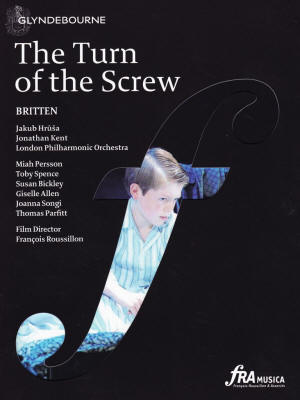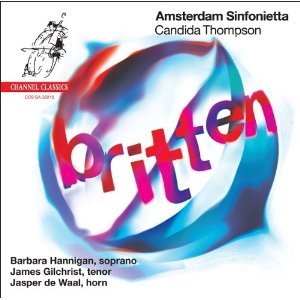|
You are reading the older HTML site
Positive Feedback ISSUE 65
Notes of an Amateur: Happy 100th Birthday, Benjamin
Britten.
Benjamin Britten's 100th birthday is now in full swing. We had Anthony Marwood in the Violin Concerto late in 2012, several cycles of his songs are in process, and here we have a release of all of his music for cello, a DVD of arguably his best opera, and a program of well known Britten staples. Rumors of a set of the music for string quartet from the Alexander Quart are also floating about.
Britten, Cello Symphony, Cello Sonata, & Cello Suites. Alban Gerhardt, cello. Steven Osborne, piano. Scottish Symphony Orchestra, Andrew Manze. Hyperion CDA 7941/2. Alban Gerhardt delivers the three Cello Suites with a clarity and firmness that provides a welcome backbone for their melancholy. He expresses Britten's stoicism where Rostropovich unearths his passion. Yes, Gerhardt is German and yes, he plays with the discipline we have come to expect from (or attribute to) German musicians. But rather than restrict, as one might expect, his discipline seems to draw new powers of expression from this music. We are accustomed to Rostropovich's rich, brooding Russian romanticism emanating from the suites and instead hear powerful German... classicism? There is no brooding here. And we are right to ask, which suites did Britten really write? This is what centenaries of composers' births are for: rediscovery, revaluation—and perhaps re-visioning. Rostropovich knew Britten personally and their closeness seems to have induced him to express the composer's inner life as if it were the whole man. Gerhardt knew Britten not at all, which may have enabled him to be more objective about what Britten actually wrote: music which expresses the inner feelings in the form they took when addressed to the world by the composer's astute, brave, moral imagination. Early music veteran violinist & conductor Andrew Manze seems an unlikely partner for Gerhardt in Britten's Symphony for Cello and Orchestra. Together they give us a more cerebral view of the work than any I've heard, but the work can stand it and emerges with both its clarity and powerful angst intact. The tortured complexity of the orchestral music comes to the surface where it grapples with the solo cello, which remains as clear and stoical as it is in the suites. The result is neo-classical Britten, all hints of neo-romanticism which haunt the Rostropovich and Müller-Schott performances subdued. Until the extraordinary entry of the work's final Passacaglia finale, when even Manze can't hold back the emotional dam—a great ending to an interesting performance. In the Sonata in C for Cello and Piano, Gerhardt and pianist Steven Osborne give us a terrifically exciting performance—I've never heard a better one. Full of passionate solos from both performers and great synergy between them. It's still Gerhardt's view of Britten, and here it is utterly convincing.
Benjamin Britten was captivated by the aesthetic beauty and aura of often threatened innocence surrounding children, young boys in particular. Some of his best known and most eloquent choral music (Ceremony of Carols, Rejoice in the Lamb) celebrates this beauty and fragile innocence; and several of his operas explore its troubled fate in the world of adults. As someone at the relatively benign end of the spectrum which has predatory pedophilia at its extreme other end, Britten was intimately aware of the source of predation of the young. Which is the same source of all evil: the undisciplined indulgence of deviant desire which causes it to become malignant. If not the privation of good, at least the privation of the natural. Britten saw the war between idealized aesthetic attraction to children and malignant sexual desire for them as a powerful instance of, in effect, The Fall. He takes on this subject in several of his operas which are, as we might expect, tragedies. The Turn of the Screw may be the most powerful of the them. It is also probably the best. What makes The Turn of the Screw such an extraordinary opera is both its moral and psychological acuity and the stunning music it marries to the story. The story on which the opera is based, as many of you likely know, was written by Henry James. For James, the young (20 year old) governess is the central character. It is all told from her point of view and it is the gradual growth of the hallucinatory and ultimately destructive power of her frustrated romantic imagination that turns the story to tragedy. Her delusional love of her handsome, absent, and inaccessible employer induces her to conjure up a enemy to fight on behalf of his children, her charges. She conjures a threatening ghost of a real man, just a year or two dead, Peter Quint, the sexually predatory pedophile and former valet of her employer who, we are made certain seduced young Miles (aged ten). She also conjures the ghost of the previous governess, Miss Jessel, whom Quint presumably romanced in order to get to the boy. The gist of this history comes to the governess in sketchy but highly credible suggestions from the housekeeper, which the governess embellishes in her mind. The governess's heroic misguided campaign against the imagined ghosts serves to revive and give new life to Miles' smoldering guilt about his seduction. Miles (and Flora his eight year old sister) fight the governess off as best they can, but she ultimately drives Miles to believe the ghost of Quint is not only real but the devil himself, which finishes him off. Flora, whose relationship with the previous governess was likely less troubling, resists the governess's madness altogether, seeing her as the problem and not any ghosts, and flees with the housekeeper. Britten, who in a visual medium really has to put the ghosts on the stage and hence address the real characters behind them, is eager to do just that because his interest in James' material is more comprehensive. And this is 1955, not 1900, so he feels freer not only to speculate but say more as well. He sees possibilities in all of the characters: the governess and her insane romantic illusions (which even come to include signs of an attraction to Miles, which the boy sometimes seems to tease her about, calling her "my dear"); the children, Miles in particular, ultimately caught in the adult crossfire between the governess's love gone wild and a revived and intensified sense of personal guilt caused by the governess's insistence on the reality of his seducer's ghost; and even the tortured minds of the real Quint and Jessel in conflict with their sexual hunger for the children and knowledge that they destroyed their innocence to feed it. "The ceremony of innocence is drowned," Britten has Quint say, with this line from Yeats. (This aspect of the story is Britten's addition to the tale, as it is, of course, beyond the imagination of the governess who is absent during their scenes together. That Jessel and Flora were sexually involved is also Britten's inventive speculation. (If this is true, it is buried fairly deep in James's telling of the story.) The complexities and vulnerabilities of childhood innocence and the tortured nature of distorted, pathological adult sexuality, both hetero—and homosexual, are the story for Britten. Britten's version of the story makes great opera, as unseemly as I make it sound! My first introduction to the composer was a live performance of The Turn of the Screw under a huge tent along the Charles River in Cambridge in the early 1960's. I have no idea who the performers were but I've never gotten over it. So I was eager to watch and write about this new Blue Ray DVD of a performance at Glyndebourne in 2011. What is best about this version of the opera is that it is a film of a live performance, which thankfully limits the distortions an ambitious filmmaker can introduce. What is distinctive about it is mainly the staging—abstract rather than the usual Victorian—which enables the set to take on a role in the haunting all around. The effect is to chill things a bit and imply through abstraction the timelessness of the tale. Also, various things that are implicit in the James story and even more so in Britten's libretto are made explicit in this production. For example, Quint's and Miss Jessel's lament over what they've lost takes place not out on edge of the lake nearby as is usual in earlier productions of the opera but over the beds of Miles and Flora! Britten takes pains to see as deeply and clearly into as many corners of the tale as an English opera of 1955 will allow; this production, a half century later, abets his efforts considerably. The six person cast are all fine, both as singers and as actors, though it's hard to find people who are the right age for these roles who can also sing. The woman playing the twenty year old governess is clearly mature. The girl who plays Flora is also a bit old for the part. And for one last quibble, Quint looks very hale for a ghost—though a pale Miss Jessel with unkempt hair makes up for him! A BBC production of the opera (2005) is a pure film and draws on the full resources of the medium: lots of foggy scenes of the lake, rapid changes of camera angle, etc. And it takes some heavy handed interpretive liberties as well. The film begins with Miles and Flora (who look about as innocent as moody ferrets) laying flowers on what we are clearly to assume are the graves of Quint and Miss Jessel. The director clearly wants us to assure us that Quint and Jessel are already a very powerful presence in both children's lives, which it won't take the mind of any outsider to revive. And sure enough, we get brief glimpses (below the shoulders) of a large, caped man walking about the premises, a scene or two later followed by a shawled women, also in three quarters view. So the governess can't be nuts and there goes half the story. Henry James must surely have turned in his grave when this film came out, with Britten not far behind. It's all very gothic and melodramatic. And the governess looks to be in her late thirties or early forties. I gave it ten minutes and fled. The Glyndebourne production is not perfect but it doesn't have to be. It gets the essence of the opera right, introduces some interesting and appropriate enhancements, and doesn't make any mistakes that matter. The set is a calculated risk, trading off a Victorian house in the country, which would be expensive even if only a partial set, for modernist severity. As a whole, this release is definitely worth seeing. But if you ever can, track down a live production. A great work just beginning to get its due. And then, of course, read James' story, which is of necessity more tightly focused and, with the advantage of narrative prose, subtler and more exact. We are locked inside the self-deceiving, unraveling mind of the governess and as a result see her delusion take form, a thought at a time, see how she plants and then feeds on false evidence of the ghosts' reality, draws patently false conclusions to confirm their existence to herself, the housekeeper, and the children in order to make real her campaign to impress her employer. It is a masterful study of how a passion and good intentions fed by it can lead one to destructive madness. James' subject is almost always the psychology of evil, a subject on which he is peerless.
Britten. Illuminations; Variations on a Theme of Frank Bridge; Serenade for Tenor, Horn, and Strings; and Now Sleeps the Crimson Petal. Barbara Hannigan, soprano. James Gilchrist, tenor. Jasper de Waal, horn. Amsterdam Sinfonietta, Candida Thompson. Channel Classics CS SA 32213. Three staples of the Britten oeuvre along with a prize that centenary celebrations are supposed to bring when they're doing their job—a new discovery, at least for me. This is the first performance of Variations on a Theme of Frank Bridge, an early Britten piece (1937) written when Britten was 22, that has persuaded me it's more than a musical exercise. Bridge was a minor British composer who was Britten's most important teacher and the work was written for him. There are the light sections I remember but also some others that are truly moving. In these, Britten catches hold of a quality that seems to come from nowhere and which we'll hear again as he matures. Britten did not write much serious music for full orchestra alone, no symphonies in particular. The Symphony for Cello is as close as he came, and for good reasons we consider that a concerto. He generally thought in smaller units when writing for instrumental music: suites with sections expressing different moods—and chamber music. I suspect this tendency is partly responsible for the equivocal attitude toward his stature—and why his reputation rests so heavily on his operas. We treat short story writers the same way. Les Illuminations (1939) a setting of Rimbaud's poetry for soprano and orchestra, is from Britten's ‘urban' side. Its ten sections vary some in mood, as is typical of the composer; but the prevailing mood is one of sophistication. The seventh section, "Interlude," admits the darker, pensive Britten for a couple (literally) of minutes and then the eighth, "Being Beauteous," guides us gracefully back to the work's dominant style again, which endures for one more section before the final "Depart," which feels like the exit of a melancholy clown. Set alongside the other works on the album, Les Illuminations feels like a bit of an anomaly. Enjoyable but eccentric and not a little surreal, like Rimbaud. The entrée on this album is the 1943 Serenade for Tenor, Horn, and Strings, one of Britten's most deservedly beloved works. Composed for tenor Peter Pears and horn player Dennis Brain, Britten declared it a minor work but history has disagreed. It is at the center of what he is all about. Horn player de Waal seems to rush things just a bit at first, missing a critical opportunity to set the extraordinary mood which traditionally dominates. But this turns out to be the key to his and tenor Gilchrist's interpretation of the work: they want it beautiful and dark, which indeed it is—this is a nocturnal work if there ever was one. But not singularly mournful as it can sometimes be. Gilchrist's voice, though slightly darker than Padmore's in the recording of this work with horn player Stephen Bell that was one of my favorites for 2012, has an openness and directness to it; and de Waal, a wonderful horn player, refuses to let his notes fog in the least to augment the mood. The work is made up of poems by Charles Cotton, Tennyson, Blake, Ben Jonson, Keats, and an eloquent poet called Anonymous whose dirge sits at the center of the Serenade. This performance is as good as Padmore's and Bell's but achieves its excellence in a different way, which comes clearest in the final Keats sonnet. Gilchrist's rendering of the final Keats is breathtaking but seems less conspicuously artful than Padmore's, which has a good deal of vibrato. Gilchrist's expressiveness is so powerfully unadorned, it makes the final solo horn Epilogue seem like an afterthought. The choice of the brief and rediscovered Now Sleeps the Crimson Petal for tenor, horn and strings as the album's final work returns us to the mood of the Serenade, as if someone agreed we needed to be reminded that Gilchrist's Keats had stolen the show! Great sound (CD and SACD) from Jared Sacks, as always. Equipment used for this audition: Resolution Audio Cantata CD player; Crimson CS710 preamplifier and CDS 640E monoblock amplifier; Audio Note OTO Signature integrated amplifier; Jean Marie Reynaud Orféo Supreme, Tocaro 40D, and Audio Note E/SPe HE loudspeakers; with Crimson cabling. Bob Neill, a former equipment reviewer for PF Online and For the Music, is also proprietor of Amherst Audio in Amherst, Massachusetts, which sells equipment from Audio Note, Blue Circle, Crimson Audio, JM Reynaud, and Resolution Audio.
|



